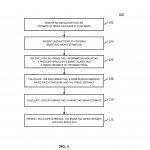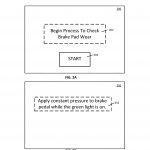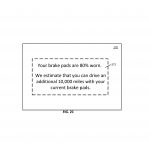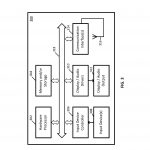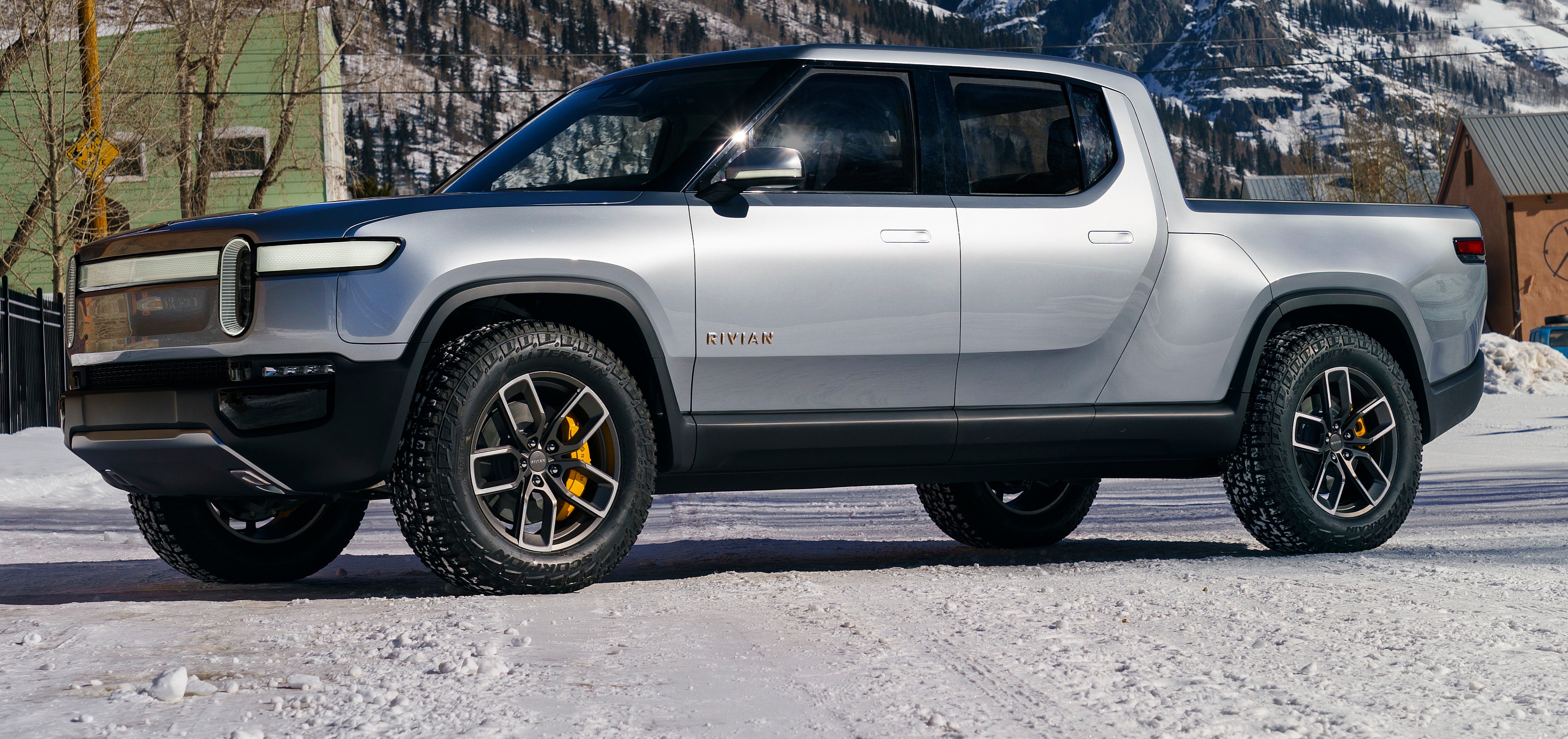

News
Rivian patent hints at real-time brake wear monitoring system using driver profiles
Rivian’s attention to detail on its all-electric vehicles is laudable, and a recent patent application by the outdoor adventure company for monitoring brake wear continues that theme. In an application titled “Methods, Systems, and Media for Non-Contact Brake Pad Wear Determination”, a method of estimating the wear on individual breaks via computer algorithms is described. Once calculated, the information is then made available to drivers for planning purposes via the infotainment screen on the R1T pickup truck and R1S SUV. The application published on August 1, 2019 under US Patent Publication No. 2019/0234475.
The background of Rivian’s application stated the following reasons why the invention is needed:
“Current approaches for determining brake pad wear…tend to merely indicate when brake pads are fully worn, for example, using a brake pad indicator that causes the brakes to squeal when the indicator contacts the brake disc or that causes an indication on a dashboard of the vehicle to be presented. It may be useful for a driver to know a current wear condition of the brake pads before the brake pads are fully worn, for example, to plan for vehicle maintenance. However, it can be difficult to determine a current wear of the brake pads.”
While not an official reason listed on the patent, one could also assume brake squealing as an annoying sound in itself would also merit the invention’s usefulness as a reliable preventative.
- Rivian brake-monitoring patent application. | Image: Rivian/USPTO
- Rivian brake-monitoring patent application. | Image: Rivian/USPTO
- Rivian brake-monitoring patent application. | Image: Rivian/USPTO
- Rivian brake-monitoring patent application. | Image: Rivian/USPTO
Overall, Rivian’s application calculates the amount of wear on its vehicles’ brakes by comparing data points gathered from two braking events. The amount of pressure applied plus the distance traveled at two different intervals is collected, then compared to a brake database, and an estimate of the mileage left before a change is needed is provided to the driver. The calculation can also include the driver’s braking history to more accurately reflect the mileage. In other words, if you’re a bit rough on the brake pedal, Rivian’s software will take that into account and probably shorten the mileage you have left before needing replacement parts compared to someone that drives…differently. Here’s the formal language for this ability:
“In some embodiments, the method further comprises associating a braking profile with an operator of the vehicle, wherein the indication of the wear amount of the brake pad includes a number of miles until the brake pad requires replacement that is estimated based on the associated braking profile.”
The method described in the claims of the application that calculate the wear on the brakes indicates a process initiated by the driver, i.e., the driver initiates a brake wear test on the center touchscreen and uses the brakes at two intervals as instructed by the vehicle’s computer to determine the wear percentage. However, the description of the application indicates that the brake testing can also happen in real-time during normal operation. The formal language for this reads as follows:
“…In some embodiments, [the testing] process…can receive a group of brake caliper measurements and corresponding brake pedal travel distances…during application of the brake pedal during normal operation of the vehicle…Additionally, in some such embodiments, [the testing] process can present indications of brake pad wear at any suitable time, such as a next time the vehicle is turned on, and/or at any other suitable time.”
This application is yet the latest nod towards Rivian’s development of a comfortable and luxury driving experience for its vehicle owners. The car maker’s branding as an outdoor electric adventure company really seems to have embraced its mission to get people outside exploring more by making the experience as convenient as possible. Whether it’s ample storage capacity, swapping out cargo modules, extending battery range with a digital jerry can, a portable kitchen built specifically for the R1T pickup truck, or now, being able to easily plan ahead for basic vehicle maintenance by checking a screen, Rivian is continuing its march against barriers to enjoying nature anywhere.
There’s a new phrase that seems to be developing based off of an old one about willpower: “Where there’s a Rivian, there’s a way.”
News
These Tesla, X, and xAI engineers were just poached by OpenAI
The news is the latest in an ongoing feud between Elon Musk and the Sam Altman-run firm OpenAI.

OpenAI, the xAI competitor for which Elon Musk previously served as a boardmember and helped to co-found, has reportedly poached high-level engineers from Tesla, along with others from xAI, X, and still others.
On Tuesday, Wired reported that OpenAI hired four high-level engineers from Tesla, xAI, and X, as seen in an internal Slack message sent by co-founder Greg Brockman. The engineers include Tesla Vice President of Software Engineering David Lau, X and xAI’s head of infrastructure engineering Uday Ruddarraju, and fellow xAI infrastructure engineer Mike Dalton. The hiring spree also included Angela Fan, an AI researcher from Meta.
“We’re excited to welcome these new members to our scaling team,” said Hannah Wong, an OpenAI spokesperson. “Our approach is to continue building and bringing together world-class infrastructure, research, and product teams to accelerate our mission and deliver the benefits of AI to hundreds of millions of people.”
Lau has been in his position as Tesla’s VP of Software Engineering since 2017, after previously working for the company’s firmware, platforms, and system integration divisions.
“It has become incredibly clear to me that accelerating progress towards safe, well-aligned artificial general intelligence is the most rewarding mission I could imagine for the next chapter of my career,” Lau said in a statement to Wired.
🚨Optimistic projections point to xAI possibly attaining profitability by 2027, according to Bloomberg's sources.
If accurate, this would be quite a feat for xAI. OpenAI, its biggest rival, is still looking at 2029 as the year it could become cash flow positive.💰 https://t.co/pE5Z9daez8
— TESLARATI (@Teslarati) June 18, 2025
READ MORE ON OPENAI: Elon Musk’s OpenAI lawsuit clears hurdle as trial looms
At xAI, Ruddarraju and Dalton both played a large role in developing the Colossus supercomputer, which is comprised of over 200,000 GPUs. One of the major ongoing projects at OpenAI is the company’s Stargate program,
“Infrastructure is where research meets reality, and OpenAI has already demonstrated this successfully,” Ruddarraju told Wired in another statement. “Stargate, in particular, is an infrastructure moonshot that perfectly matches the ambitious, systems-level challenges I love taking on.”
Elon Musk is currently in the process of suing OpenAI for shifting toward a for-profit model, as well as for accepting an investment of billions of dollars from Microsoft. OpenAI retaliated with a counterlawsuit, in which it alleges that Musk is interfering with the company’s business and engaging in unfair competition practices.
Elon Musk confirms Grok 4 launch on July 9 with livestream event
News
SpaceX share sale expected to back $400 billion valuation
The new SpaceX valuation would represent yet another record-high as far as privately-held companies in the U.S. go.

A new report this week suggests that Elon Musk-led rocket company SpaceX is considering an insider share sale that would value the company at $400 billion.
SpaceX is set to launch a primary fundraising round and sell a small number of new shares to investors, according to the report from Bloomberg, which cited people familiar with the matter who asked to remain anonymous due to the information not yet being public. Additionally, the company would sell shares from employees and early investors in a follow-up round, while the primary round would determine the price for the secondary round.
The valuation would represent the largest in history from a privately-owned company in the U.S., surpassing SpaceX’s previous record of $350 billion after a share buyback in December. Rivaling company valuations include ByteDance, the parent company of TikTok, as well as OpenAI.
Bloomberg went on to say that a SpaceX representative didn’t respond to a request for comment at the time of publishing. The publication also notes that the details of such a deal could still change, especially depending on interest from the insider sellers and share buyers.
Axiom’s Ax-4 astronauts arriving to the ISS! https://t.co/WQtTODaYfj
— TESLARATI (@Teslarati) June 26, 2025
READ MORE ON SPACEX: SpaceX to decommission Dragon spacecraft in response to Pres. Trump war of words with Elon Musk
SpaceX’s valuation comes from a few different key factors, especially including the continued expansion of the company’s Starlink satellite internet company. According to the report, Starlink accounts for over half of the company’s yearly revenue. Meanwhile, the company produced its 10 millionth Starlink kit last month.
The company also continues to develop its Starship reusable rocket program, despite the company experiencing an explosion of the rocket on the test stand in Texas last month.
The company has also launched payloads for a number of companies and government contracts. In recent weeks, SpaceX launched Axiom’s Ax-4 mission, sending four astronauts to the International Space Station (ISS) for a 14-day stay to work on around 60 scientific experiments. The mission was launched using the SpaceX Falcon 9 rocket and a new Crew Dragon capsule, while the research is expected to span a range of fields including biology, material and physical sciences, and demonstrations of specialized technology.
News
Tesla Giga Texas continues to pile up with Cybercab castings
Tesla sure is gathering a lot of Cybercab components around the Giga Texas complex.

Tesla may be extremely tight-lipped about the new affordable models that it was expected to start producing in the first half of the year, but the company sure is gathering a lot of Cybercab castings around the Giga Texas complex. This is, at least, as per recent images taken of the facility.
Cybercab castings galore
As per longtime drone operator Joe Tegtmeyer, who has been chronicling the developments around the Giga Texas complex for several years now, the electric vehicle maker seems to be gathering hundreds of Cybercab castings around the factory.
Based on observations from industry watchers, the drone operator appears to have captured images of about 180 front and 180 rear Cybercab castings in his recent photos.
Considering the number of castings that were spotted around Giga Texas, it would appear that Tesla may indeed be preparing for the vehicle’s start of trial production sometime later this year. Interestingly enough, large numbers of Cybercab castings have been spotted around the Giga Texas complex in the past few months.
Cybercab production
The Cybercab is expected to be Tesla’s first vehicle that will adopt the company’s “unboxed” process. As per Tesla’s previous update letters, volume production of the Cybercab should start in 2026. So far, prototypes of the Cybercab have been spotted testing around Giga Texas, and expectations are high that the vehicle’s initial trial production should start this year.
With the start of Tesla’s dedicated Robotaxi service around Austin, it might only be a matter of time before the Cybercab starts being tested on public roads as well. When this happens, it would be very difficult to deny the fact that Tesla really does have a safe, working autonomous driving system, and it has the perfect vehicle for it, too.
-

 Elon Musk1 week ago
Elon Musk1 week agoTesla investors will be shocked by Jim Cramer’s latest assessment
-

 News2 weeks ago
News2 weeks agoTesla Robotaxi’s biggest challenge seems to be this one thing
-

 Elon Musk1 day ago
Elon Musk1 day agoElon Musk confirms Grok 4 launch on July 9 with livestream event
-

 News2 weeks ago
News2 weeks agoWatch the first true Tesla Robotaxi intervention by safety monitor
-

 News5 days ago
News5 days agoTesla Model 3 ranks as the safest new car in Europe for 2025, per Euro NCAP tests
-

 Elon Musk2 weeks ago
Elon Musk2 weeks agoA Tesla just delivered itself to a customer autonomously, Elon Musk confirms
-

 Elon Musk2 weeks ago
Elon Musk2 weeks agoElon Musk confirms Tesla Optimus V3 already uses Grok voice AI
-

 Elon Musk2 weeks ago
Elon Musk2 weeks agoxAI welcomes Memphis pollution results, environmental groups push back

